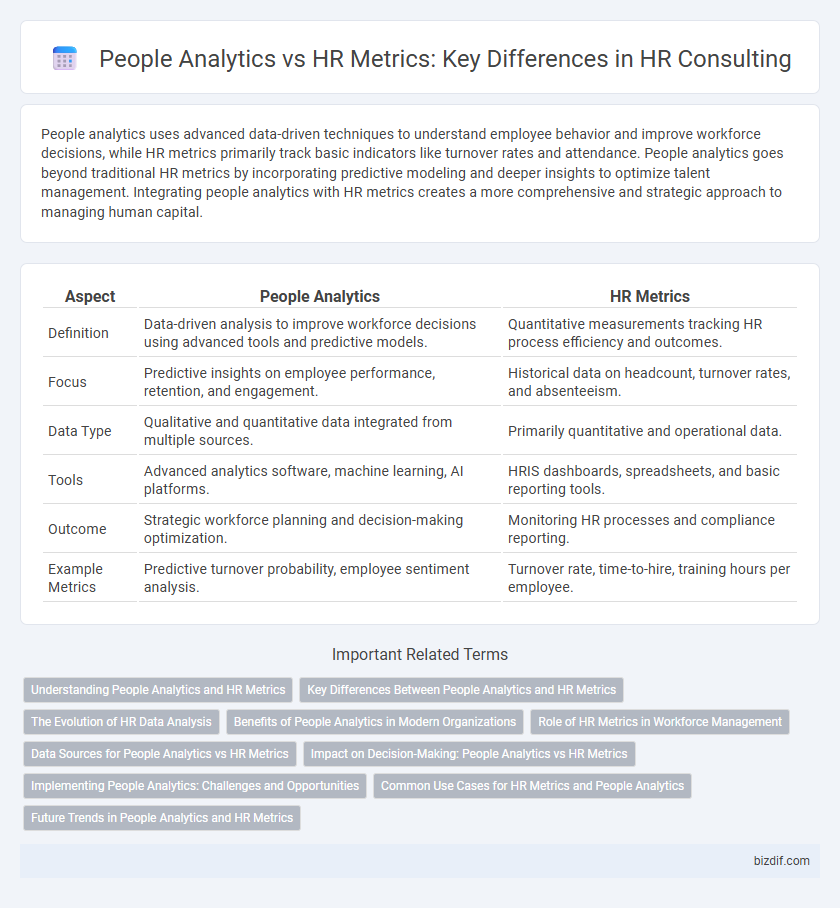People analytics uses advanced data-driven techniques to understand employee behavior and improve workforce decisions, while HR metrics primarily track basic indicators like turnover rates and attendance. People analytics goes beyond traditional HR metrics by incorporating predictive modeling and deeper insights to optimize talent management. Integrating people analytics with HR metrics creates a more comprehensive and strategic approach to managing human capital.
Table of Comparison
| Aspect | People Analytics | HR Metrics |
|---|---|---|
| Definition | Data-driven analysis to improve workforce decisions using advanced tools and predictive models. | Quantitative measurements tracking HR process efficiency and outcomes. |
| Focus | Predictive insights on employee performance, retention, and engagement. | Historical data on headcount, turnover rates, and absenteeism. |
| Data Type | Qualitative and quantitative data integrated from multiple sources. | Primarily quantitative and operational data. |
| Tools | Advanced analytics software, machine learning, AI platforms. | HRIS dashboards, spreadsheets, and basic reporting tools. |
| Outcome | Strategic workforce planning and decision-making optimization. | Monitoring HR processes and compliance reporting. |
| Example Metrics | Predictive turnover probability, employee sentiment analysis. | Turnover rate, time-to-hire, training hours per employee. |
Understanding People Analytics and HR Metrics
People analytics involves leveraging advanced data science techniques and predictive modeling to uncover deep insights about employee behavior and organizational performance, going beyond traditional HR metrics which primarily focus on descriptive data like turnover rates and headcount. HR metrics provide essential quantitative measurements that track workforce trends, but people analytics interprets this data to inform strategic decisions and improve talent management outcomes. Understanding the distinction enhances data-driven approaches to optimize recruitment, engagement, and retention strategies in HR consulting.
Key Differences Between People Analytics and HR Metrics
People analytics leverages advanced data science techniques and predictive modeling to uncover insights about workforce behaviors and trends, driving strategic decision-making and talent management. HR metrics primarily focus on descriptive statistics such as turnover rates, absenteeism, and employee satisfaction scores, providing historical and operational snapshots. The key difference lies in people analytics' proactive, evidence-based approach aimed at forecasting and improving business outcomes, whereas HR metrics serve as basic performance indicators for monitoring human resource activities.
The Evolution of HR Data Analysis
People analytics represents the advanced evolution of HR data analysis, moving beyond traditional HR metrics that primarily track basic workforce statistics like turnover and attendance. It integrates complex data sources and predictive algorithms to provide actionable insights on employee behavior, performance, and engagement. This shift enables HR professionals to make data-driven decisions that enhance talent management, optimize workforce planning, and improve organizational outcomes.
Benefits of People Analytics in Modern Organizations
People analytics provides deeper insights into workforce behaviors and performance by leveraging advanced data analysis techniques beyond traditional HR metrics that primarily track basic status indicators. It enables modern organizations to make data-driven decisions, improve talent management, and enhance employee engagement through predictive modeling and trend analysis. By unlocking actionable intelligence, people analytics drives strategic workforce planning, reduces turnover, and boosts overall organizational productivity.
Role of HR Metrics in Workforce Management
HR metrics play a crucial role in workforce management by providing quantifiable data on employee performance, attendance, and turnover rates. These metrics enable HR professionals to identify trends, measure productivity, and make informed decisions about staffing and resource allocation. Unlike people analytics, which focuses on predictive insights and behavioral patterns, HR metrics deliver essential baseline measurements that support operational efficiency and compliance.
Data Sources for People Analytics vs HR Metrics
People analytics leverages diverse data sources including employee surveys, performance reviews, social network analysis, and real-time productivity tracking to deliver predictive insights and strategic workforce planning. HR metrics primarily rely on structured data such as payroll, headcount, turnover rates, and attendance records, offering a retrospective and quantitative view of HR operations. Integrating unstructured and behavioral data sets in people analytics enables deeper understanding of employee engagement and talent trends beyond traditional HR metrics.
Impact on Decision-Making: People Analytics vs HR Metrics
People analytics leverages advanced data modeling and predictive insights to drive strategic decision-making in talent management, enhancing workforce planning and employee engagement outcomes. HR metrics provide descriptive data that track basic HR functions like turnover rates and attendance, offering a foundational understanding but limited foresight. Integrating people analytics enables HR leaders to make evidence-based decisions with greater accuracy, fostering proactive interventions rather than reactive measures.
Implementing People Analytics: Challenges and Opportunities
Implementing people analytics in HR presents challenges such as data integration complexities, ensuring data privacy compliance, and developing analytical skills among HR professionals. Opportunities include enabling data-driven decision-making, improving talent management strategies, and enhancing workforce productivity through predictive insights. Organizations embracing people analytics gain a competitive edge by transforming raw HR metrics into actionable intelligence.
Common Use Cases for HR Metrics and People Analytics
HR metrics commonly track employee turnover rates, time-to-hire, and absenteeism to measure workforce efficiency and engagement, providing essential data for operational decision-making. People analytics leverages advanced statistical models and machine learning to predict employee performance, identify skill gaps, and optimize talent management strategies. Combining HR metrics with people analytics enables organizations to transform raw data into actionable insights for improving recruitment, retention, and employee development programs.
Future Trends in People Analytics and HR Metrics
Future trends in people analytics emphasize advanced predictive modeling and AI-driven insights to enhance talent management and employee experience, surpassing traditional HR metrics focused on descriptive data. Integration of real-time data sources and machine learning algorithms enables organizations to anticipate workforce needs, reduce turnover, and optimize performance with greater precision. The shift toward strategic, data-driven decision-making in HR reflects an evolving landscape where analytics drive proactive interventions and continuous organizational improvement.
people analytics vs HR metrics Infographic

 bizdif.com
bizdif.com